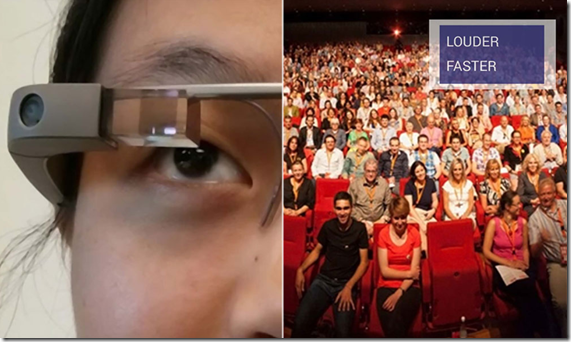Can Wearable Technology Make You A Better Presenter?
If you’re a regular reader of this blog, you know that we have mixed feelings about public speaking “crutches,” such as Teleprompters.
Generally speaking, we’d rather teach public speakers how to deliver more effective presentations without depending on technology to get them through. Many speaking situations—conversations at dinner parties, meetings around corporate boardroom tables, and many others—aren’t conducive to such technology.
Therefore, it’s far more important to learn the skills that can be deployed at any time, to any group, regardless of the availability of technology.
However, it’s also important to remain open to new ideas, and recent research conducted by the Human-Computer Interaction Group at the University of Rochester is worth considering. For their research, the group sent “real-time feedback” to speakers regarding their “volume modulation and speaking rate.”
The short video below explains the research and their findings.
The first thing that occurred to me is that receiving real-time messages could be distracting for the speaker. The researchers admit as much:
“One challenge is to keep the speakers informed about their speaking performance without distracting them from their speech,” they write. “A significant enough distraction can introduce unnatural behaviors, such as stuttering or awkward pausing. Secondly, the head mounted display is positioned near the eye, which might cause inadvertent attention shifts.”
But real-time “live” feedback from an actual person to a speaker during a presentation is also distracting to speakers, so the real test I’d like to see is how one compares to the other.
Beyond being distracting to the speaker, do real-time instructions distract the audience?
“We wanted to check if the speaker looking at the feedback appearing on the glasses would be distracting to the audience,” Hoque said. “We also wanted the audience to rate if the person appeared spontaneous, paused too much, used too many filler words and maintained good eye contact under the three conditions: word feedback, continuous feedback, and no feedback.”
However, there was no statistically significant difference among the three groups on eye contact, use of filler words, being distracted, and appearing stiff.
The researchers used only 30 subjects in their research, so it’s too limited a sample to know how broadly their findings could be applied (they want to test their technology with Toastmasters to get a better sample, which seems like a great idea).
I also question whether the obtrusive glasses themselves can distract an audience, which is aware that the speaker may be receiving real-time feedback and is abruptly changing their pace and volume.
Finally, who’s to determine the “proper” speaking rate? There’s a normal accepted range, but some speakers, for some topics and to some audiences, might be wise to adjust it. (Difficult or complex content might be delivered slower; exciting content intended to motivate might be delivered quicker.)
Either way, I find this research interesting and look forward to following similar future work. Perhaps it could be a useful tool in limited circumstances as the glasses become smaller and sleeker.
You can download the software for free here. Photo credit: M. Iftekhar Tanveer, et al
Want to learn more about public speaking? Check out our recommended reading list!




It seems to me this could be useful as a training tool, similar to the usefulness of taping oneself and then critiquing performance with an eye toward improvement. Practicing the presentation with real-time feedback could quickly improve cadence, volume and so on. But I am less convinced that this would be a good tool for the actual presentation. When I watched the short clip I found the presence of the glass on the presenter immediately distracting as a viewer.